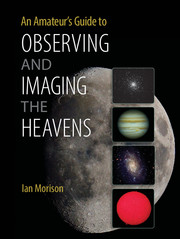Book contents
- Frontmatter
- Dedication
- Contents
- Preface
- Acknowledgements
- Prologue A Tale of Two Scopes
- 1 Telescope and Observing Fundamentals
- 2 Refractors
- 3 Binoculars and Spotting Scopes
- 4 The Newtonian Telescope and Its Derivatives
- 5 The Cassegrain Telescope and Its Derivatives
- 6 Telescope Maintenance, Collimation and Star Testing
- 7 Telescope Accessories
- 8 Telescope Mounts
- 9 The Art of Visual Observing
- 10 Visual Observations of the Moon and Planets
- 11 Imaging the Moon and Planets
- 12 Observing and Imaging the Sun
- 13 Observing and Imaging with an Astro-Video Camera
- 14 DSLR Deep-Sky Imaging
- 15 Imaging with Cooled CCD Cameras
- 16 Auto-Guiding and Drift Scan Alignment
- 17 Spectral Studies
- 18 Improving and Enhancing Images in Photoshop
- Index
- Plate Section
16 - Auto-Guiding and Drift Scan Alignment
Published online by Cambridge University Press: 05 June 2014
- Frontmatter
- Dedication
- Contents
- Preface
- Acknowledgements
- Prologue A Tale of Two Scopes
- 1 Telescope and Observing Fundamentals
- 2 Refractors
- 3 Binoculars and Spotting Scopes
- 4 The Newtonian Telescope and Its Derivatives
- 5 The Cassegrain Telescope and Its Derivatives
- 6 Telescope Maintenance, Collimation and Star Testing
- 7 Telescope Accessories
- 8 Telescope Mounts
- 9 The Art of Visual Observing
- 10 Visual Observations of the Moon and Planets
- 11 Imaging the Moon and Planets
- 12 Observing and Imaging the Sun
- 13 Observing and Imaging with an Astro-Video Camera
- 14 DSLR Deep-Sky Imaging
- 15 Imaging with Cooled CCD Cameras
- 16 Auto-Guiding and Drift Scan Alignment
- 17 Spectral Studies
- 18 Improving and Enhancing Images in Photoshop
- Index
- Plate Section
Summary
In several earlier examples it has been shown how one can give the effect of one long exposure by stacking a number of sub-exposures. Most telescope mounts can track sufficiently well to allow exposures of up to 60 seconds without elongating the star images, so why bother to auto-guide? The fundamental reason is that longer exposures have a greater signal-to-noise ratio than short ones so, in principle, one 60-minute exposure would be better than the stacking of sixty 1-minute exposures. Stacking a number of images does increase the signal-to-noise ratio but not quite enough to compensate. The maths relating to this is somewhat complex and will not be covered here, but it turns out that to get the equivalent to one 60-minute exposure would require perhaps eighty 1-minute exposures to be stacked.
But it would be totally stupid to attempt a single 60-minute exposure: firstly, any bright stars in the field would be grossly over-exposed, causing highly unattractive ‘blooming’ of their images; secondly, the chance of a single 60-minute exposure not having a satellite or aircraft trail is quite low; and thirdly, for best results, you are going to have to take a number of 60-minute dark frames. As a result, astro-imagers have to compromise. An optimum strategy might well be to take eight or nine 10-minute exposures to give a comparable result, but care must be taken not to over-expose an important part of the image, for example, the core of M31 discussed in the preceding chapter.
- Type
- Chapter
- Information
- An Amateur's Guide to Observing and Imaging the Heavens , pp. 268 - 282Publisher: Cambridge University PressPrint publication year: 2014



